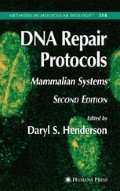Abstract
DNA damage that leads to formation of DNA double-strand breaks (DSBs) induces phosphorylation of histone H2AX on Ser-139 at sites flanking the breakage. Immunocytochemical detection of phosphorylated H2AX (denoted as γH2AX) thus provides a marker of DSBs. The method presented in this chapter describes the detection of γH2AX for revealing the presence of DSBs, combined with differential staining of cellular DNA for revealing the cell cycle phase. The detection of γH2AX is based on indirect immunofluorescence using secondary antibody tagged with fluorescein isothiocyanate (FITC) while DNA is counterstained with propidium iodide (PI). Intensity of cellular green (FITC) and red (PI) fluorescence is measured by flow cytometry and bivariate analysis of the data is used to correlate the presence of DSBs with the cell cycle phase.
Access this chapter
Tax calculation will be finalised at checkout
Purchases are for personal use only
References
Rogakou, E. P., Pilch, D. R., Orr, A. H., Ivanova, V. S., and Bonner, W. M. (1998) DNA double-stranded breaks induce histone H2AX phosphorylation on serine 139. J. Biol. Chem. 273, 5858–5868.
West, M. H. and Bonner, W. M. (1980) Histone 2A, a heteromorphous family of eight protein species. Biochemistry 19, 3238–3245.
Burma, S., Chen, B. P., Murphy, M., Kurimasa, A., and Chen, D. J. (2001) ATM phosphorylates histone H2AX in response to DNA double-strand breaks. J. Biol. Chem. 276, 42,462–42,467.
Furuta, T., Takemura, H., Liao, Z.-Y., et al. (2003) Phosphorylation of histone H2AX and activation of Mre11, Rad50, and Nbs1 in response to replication-dependent DNA double-strand breaks induced by mammalian topoisomerase I cleavage complexes. J. Biol. Chem. 278, 20,303–20,312.
Park, E. J., Chan, D. W., Park, J. H., Oettinger, M. A., and Kwon, J. (2003) DNAPK is activated by nucleosomes and phosphorylated H2AX within the nucleosomes in an acetylation-dependent manner. Nucleic Acids Res. 31, 6819–6827.
Rogakou, E. P., Boon, C., Redon, C., and Bonner W. M. (1999) Megabase chromatin domains involved in DNA double-strand breaks in vivo. J. Cell Biol. 146, 905–916.
Sedelnikova, O. A., Rogakou, E. P., Panuytin, I. G., and Bonner, W. (2002) Quantitive detection of 125IUdr-induced DNA double-strand breaks with γ-H2AX antibody. Radiation Res. 158, 486–492.
MacPhail, S. H., Banath, J. P., Yu, Y., Chu, E., and Olive, P. L. (2003) Cell cycle-dependent expression of phosphorylated histone H2AX: reduced expression in unirradiated but not X-irradiated G1-phase cells. Radiat. Res. 159, 759–767.
MacPhail, S. H., Banath, J. P., Yu, T. Y., Chu, E. H., Lambur, H., and Olive, P. L. (2003) Expression of phosphorylated histone H2AX in cultured cell lines following exposure to X-rays. Int. J. Radiat. Biol. 79, 351–358.
Yoshida, K., Yoshida, S. H., Shimoda, C., and Morita, T. (2003) Expression and radiation-induced phosphorylation of H2AX in mammalian cells. J. Radiat. Res. (Tokyo) 44, 47–51.
Huang, X., Okafuji, M., Traganos, F., Luther, E., Holden, E., and Darzynkiewicz, Z. (2004) Assessment of histone H2AX phosphorylation induced by DNA topoisomerase I and II inhibitors topotecan and mitoxantrone and by DNA crosslinking agent cisplatin. Cytometry 58A, 99–110.
Huang, X., Traganos, F., and Darzynkiewicz, Z. (2003) DNA damage induced by DNA topoisomerase I-or topoisomerase II-inhibitors detected by histone H2AX phosphorylation in relation to the cell cycle phase and apoptosis. Cell Cycle 2, 614–619.
Albino, A. P., Huang, X., Jorgensen, E., et al. (2004) Induction of histone H2AX phosphorylation in A549 human pulmonary adenocarcinoma cells by tobacco smoke and in human bronchial epithelial cells by smoke condensate: a new assay to detect the presence of potential carcinogens in tobacco. Cell Cycle 3, 1062–1068.
Speit, G. and Hartmann, A. (1999) The comet assay (single-cell gel test): a sensitive genotoxicity test for detection of DNA damage and repair. Methods Mol. Biol. 113, 203–212.
Downs, J. A., Lowndes, N. F., and Jackson, S. P. (2000) A role for Saccharomyces cerevisiae histone H2A in DNA repair. Nature 408, 1001–1004.
Jackson, S. P. (2001) DNA damage signaling and apoptosis. Biochem. Soc. Transactions 29, 655–661.
Gorczyca, W., Bruno, S., Darzynkiewicz, R. J., Gong, J., and Darzynkiewicz, Z. (1992) DNA strand breaks occurring during apoptosis: their early in situ detection by the terminal-deoxynucleotidyl transferase and nick translation and prevention by serine protease inhibitors. Int. J. Oncol. 1, 639–648.
Marzluff, W. F. and Duronio, R. J. (2002) Histone mRNA expression: multiple levels of cell cycle regulation and important developmental consequences. Curr. Opin. Cell Biol. 14, 692–699.
Acknowledgments
This work was supported by NCI grant RO1 28704.
Author information
Authors and Affiliations
Editor information
Editors and Affiliations
Rights and permissions
Copyright information
© 2006 Humana Press Inc.
About this protocol
Cite this protocol
Huang, X., Darzynkiewicz, Z. (2006). Cytometric Assessment of Histone H2AX Phosphorylation. In: Henderson, D.S. (eds) DNA Repair Protocols. Methods in Molecular Biology™, vol 314. Humana Press. https://doi.org/10.1385/1-59259-973-7:073
Download citation
DOI: https://doi.org/10.1385/1-59259-973-7:073
Publisher Name: Humana Press
Print ISBN: 978-1-58829-513-2
Online ISBN: 978-1-59259-973-8
eBook Packages: Springer Protocols

